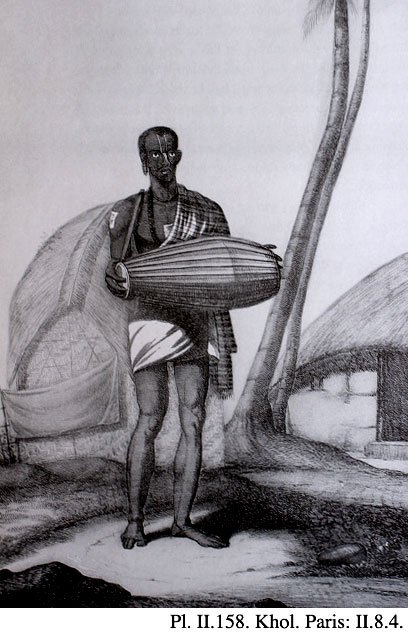From A Portrait of the Hindus: Balthazar Solvyns
& the European Image of India 1760-1824
 As promised, from Robert L. Hardgrave’s A Portrait of the Hindus, Balthazar Solvyns’s etching of the khol or mridanga drum. Here, I’ve provided a detail of the etching. The entire image can be found below. I’ve included an excerpt from the description by the artist, Balthazar Solvyns, and below that, an excerpt from Robert Hardgrave’s commentary, (I’ve not included the footnotes). One observation of my own: it appears that the musician is wearing, around his right ear, a small pushpa-mala (flower garland). This would most likely have been an offering to a small murti of Krishna and is worn as prasad or a blessing. Due to its small size, such a garland is sometimes worn around the ear.
As promised, from Robert L. Hardgrave’s A Portrait of the Hindus, Balthazar Solvyns’s etching of the khol or mridanga drum. Here, I’ve provided a detail of the etching. The entire image can be found below. I’ve included an excerpt from the description by the artist, Balthazar Solvyns, and below that, an excerpt from Robert Hardgrave’s commentary, (I’ve not included the footnotes). One observation of my own: it appears that the musician is wearing, around his right ear, a small pushpa-mala (flower garland). This would most likely have been an offering to a small murti of Krishna and is worn as prasad or a blessing. Due to its small size, such a garland is sometimes worn around the ear.
At the bottom of the post I’ve included links with more information about A Portrait of the Hindus. The images and text have been used with the kind permission of the book’s author Robert L. Hardgrave. More to come!
Paris:II.8.4. KHOLE, OR MIRDEN:
Although many people look upon this instrument as sacred, and that it is often seen especially in their religious festivals, in the hands of the devout Hindoos, such as Faquirs and Beeshnubs (Baisnab), it is not less true that the people make use of it also at their feasts. The form of the Khole is exactly such as I have represented it in this engraving; it is sufficient to look at it, to have a perfect idea of this instrument, which consists merely in a piece of earthen ware covered at the two ends with a skin stretched like our drums, except that the lower end is wider and produces a deeper sound than the upper. It is not necessary to remark that the music of the Khole is as monotonous as that of the other instruments which I have been describing. But the Hindoos, on the contrary, find in it an extraordinary charm, and pretend that, accompanied by the voice, this instrument is capable of expressing all the emotions of the soul, from the most violent to the most tender.
Commentary: The khol is a classical Indian double-headed drum of eastern India. The body is made from clay in an asymmetrical barrel shape. The tapering toward the right end of the Khol’s body is more sharply accentuated than that of the classical pakhavaj (PL. II.163) associated with the dhrupad tradition of North Indian music. Like the pakhavaj, the khol has a treble right head tuned to a specific pitch and a lower-pitched bass left head. However, the khol is tuned higher than the pakhavaj and has a metallic timbre.
The khol is closely associated with kirtan (devotional singing) of the Vaisnava tradition of Sri Caitanya Mahaprabhu, the late sixteenth century bhakti poet-saint of Bengal. The instrument continues to be looked upon as sacred by Vaisnava devotees of this sect, and its worship, along with that of the kartal cymbals, still forms part of the ritual practices of the kirtan event. Solvyns depicts the use of the khol – which he refers to as “mirdun” (mrdanga) – along with the bak and kartal in his portrayal of Hari Sankirtan (PL.II.184), a congregational singing of devotional songs praising Hari (an epithet of Visnu). The practice is believed to have been begun by Caitanya.
The “Beeshnubs’ (Baisnabs) mentioned by Solvyns are Vaisnava. Solvyns portrays a Baisnab in one of the etchings depicting Hindu ascetics (PL.II.138), and writes that they are “individuals who, after having renounced all pleasures of life, the riches and good things of the earth, devote themselves to the worship of Vishnou.” The figure depicted in the etching wears the mark of Visnu on his forehead. The “faquirs” mentioned might have been Bauls, who are known to have adopted the khol from the Vaisnava tradition.

For information of the on the Solvyns Project click here.
To view Solvyns’ etchings online click here.
A Portrait of the Hindus can be purchased online from the Oxford University Press.
Comments
2 responses to “An Etching of the Khol”
Great post. Here is a related picture of a blind khol player I ran into in the village of Ekachakra, West Bengal in spring 2004. They barely had electricity, and happily, the village belied little western influence. As such, I found his attire quite unexpected, though as an old Jersey guy, I liked it. He was an unbelievable khol player, and judging by the responses of locals, he was beloved in town. Next time I go, I will have to bring him a 2008 Super Bowl Champion hoodie.
http://img166.imageshack.us/img166/5203/cimg0018xn1.jpg
Great post. I read this article before about the “Beeshnubs”. However, I never saw this image. This kirtaniya is tough.
Go Eagles!